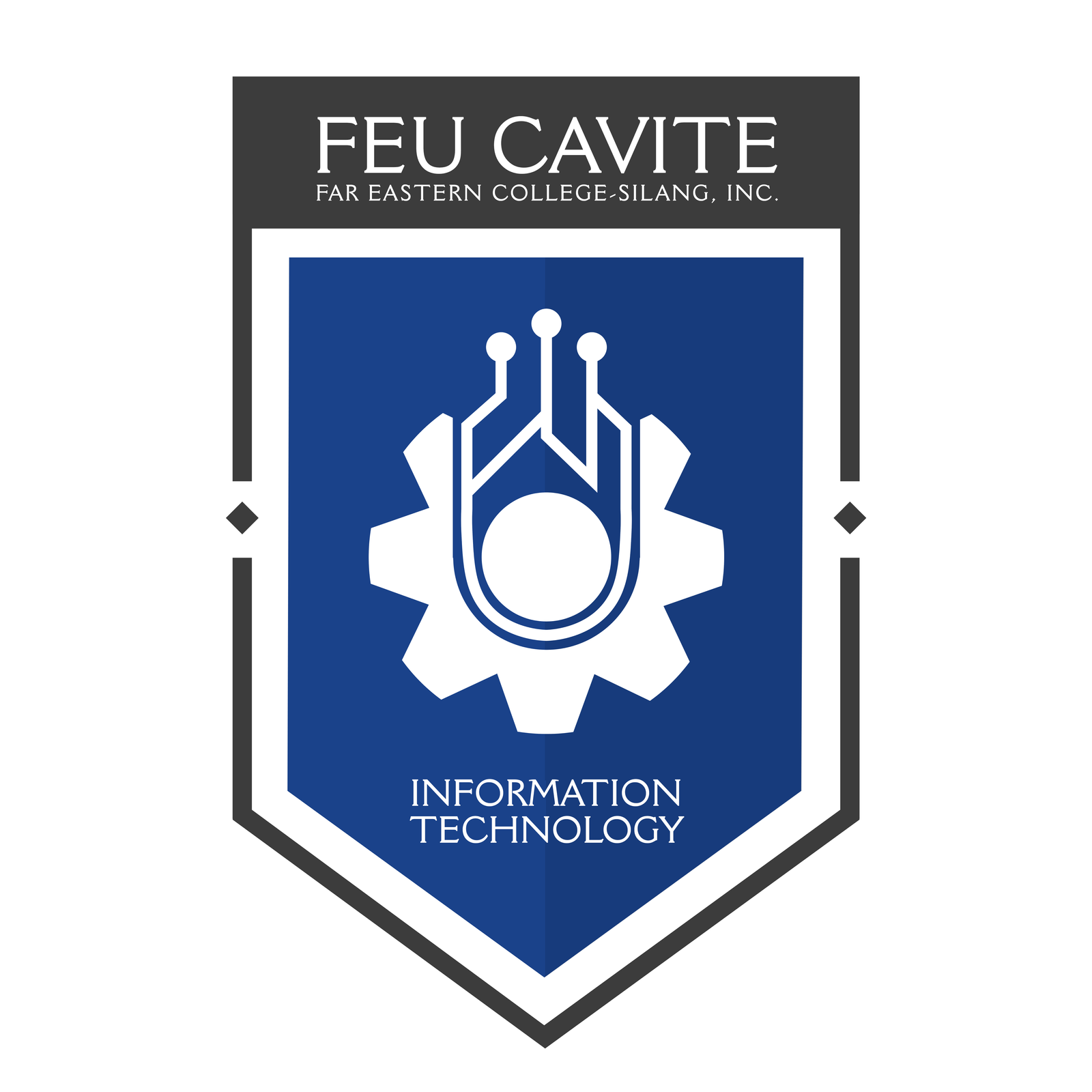Department of Information Technology

Program Offering:
1. Bachelor of Science in Information Technology
Ms. Lorielle S. Rocela, MA IT
OIC Department Chair
Office Location
Department Chair’s Office, Upper Ground Floor of HED Building
Contact Number
TEL: (046) 419 8500 loc. 206
E-mail
lrocela@feucavite.edu.ph
The Bachelor of Science in Information Technology is a four-year program which develops future IT professionals in planning, installing, customizing operating, managing, administering, and maintaining information technology infrastructure. The program also deals with the study of design, development, and implementation of solutions that integrate information technology into businesses and organizations. It aims to prepare students to be IT professionals, well-versed in IT infrastructure development and administration, and experts in systems design and development for implementation in an organization.
Program Objectives
Vision
FEU Cavite Information Technology program aims to become the Leading Producer of Competent and Career-oriented IT Professionals within the province of Cavite in the field of Full Stack Web and App development, Virtual and Augmented Reality, Infrastructure, and Cyber Forensic.
Mission
The Information technology department is committed to excellence in producing a well-equipped and well-rounded individual that is industry-competent locally and internationally by:
- exposing the students in industry-related activities;
- continuously providing faculty development and retooling activities;
- strengthening linkages;
- equipping the students with the right tools for technology advancement;
- sustaining excellence in the field of instruction through different approaches and learning modalities; and
- ensuring the suitability of the programs to national and regional needs
Program Expected Learning Outcomes
At the end of the program, graduates are expected to become:
Industry-Ready – Analyze the local and global impact of computing information technology on individuals, organizations, and society.
- Present a proposed solution in a class or public forum.
- Collaborate to multidisciplinary system development for web and mobile platforms.
Lifelong Learners – Recognize the need for and engage in planning self-learning and improving performance as a foundation for continuing professional development.
- Demonstrate independent critical thinking and problem skills.
- Recognize the need for life-long professional development and learning.
- Acquire employability skills to complement their job-specific skills.
- Pursue life-long learning that enables them to adapt and grow as organizational responsibilities change.
Functional Team Players – Function effectively as a member or leader of a development team, recognizing the different roles within a team to accomplish a common goal. Assist in the creation of an effective IT project plan.
- Work effectively in teams to develop IT based solutions.
- Function effectively as an individual and as a member or leader of diverse team and in multidisciplinary settings.
- Articulate the tasks and apply project management approach for system project development.
Operationally and Organizationally Skilled Individuals – Design, implement and evaluate computer-based systems, processes, components or programs to meet desired needs and requirements under various constraints. Integrate IT-based solutions into the user environment effectively.
- Immerse in a real-world scenario and apply innovative solutions.
- Use appropriate project management methods in the creation of an effective IT project plan.
- Demonstrate the ability to anlyze, identify, and define information system or business process system requirements.
Tech-Savvy – Apply knowledge through the use of current techniques, skills, tools, and practices necessary for the IT profession.
- Identify and apply current and emerging technologies.
- Produce user design product that focuses on the user and their needs.
- Demonstrate best practices and discipline in every phase of an user-driven development.
Effective Communicator – Communicate effectively with the computing community and with society as a whole about complex computing activities through logical writing, presentations, and clear instructions.
- Work effectively in teams to develop IT based solutions.
- Function effectively as an individual and as a member or leader of diverse team and in multidisciplinary settings.
- Articulate the tasks and apply project management approach for system project development.
Socially Responsible Professionals – Apply knowledge of computing, science, and mathematics appropriate to discipline. Understand best practices and standards and their applications. Analyze complex problems and identify and define the computing requirements appropriate to its solution. Identify and anlayze the needs of users, and take them into account in the selection, creation, evaluation, and administration of computer-based systems.
- Acquire any IT competency assessment, National certification or IT industry certification.
- Demonstate expertise in the core of information communication technology and actual technical skills sets in every tasks.
- Complete and successfully defend software project that is relevant with the discipline.
- Discuss the importance and influence of information communication technology and computing technology theories, discipline and applications.
- Articulately design solutions within the acceptance societak, aesthetic, communicative and ethical norms in IT industry and professional learnings for on-field industry workplace.
Honing One’s Full Potential – Realize creative individual talent and skills to recognize strengths for a more effective development of the full potential; self realization
- Realize Individual’s critical thinking and problem skills Ability
- Recognize individual’s opportunity for personal Development.
Career Pathways
Programming
Computer programming or coding is the composition of sequences of instructions, called programs, that computers can follow to perform tasks. It involves designing and implementing algorithms, step-by-step specifications of procedures, by writing code in one or more programming languages.
Cybersecurity
Computer security, cybersecurity, digital security, or information technology security (IT security) is the protection of computer systems and networks from attacks by malicious actors that may result in unauthorized information disclosure, theft of, or damage to hardware, software, or data, as well as from the disruption or misdirection of the services they provide.
Web Development
Web development is the work involved in developing a website for the Internet an intranet. Web development can range from developing a simple single static page of plain text to complex web applications, electronic businesses, and social network services. A more comprehensive list of tasks to which Web development commonly refers, may include Web engineering, Web design, Web content development, client liaison, client-side/server-side scripting, Web server and network security configuration, and e-commerce development.
Digital Animation
Computer animation is the process used for digitally generating moving images. The more general term computer-generated imagery (CGI) encompasses both still images and moving images, while computer animation only refers to moving images. Modern computer animation usually uses 3D computer graphics.
System Administration
An IT administrator, system administrator, sysadmin, or admin is a person who is responsible for the upkeep, configuration, and reliable operation of computer systems, especially multi-user computers, such as servers. The system administrator seeks to ensure that the uptime, performance, resources, and security of the computers they manage meet the needs of the users, without exceeding a set budget when doing so.
Mobile App Development
Mobile app development is the act or process by which a mobile app is developed for one or more mobile devices, which can include personal digital assistants (PDA), enterprise digital assistants (EDA), or mobile phones. Such software applications are specifically designed to run on mobile devices, taking numerous hardware constraints into consideration. Common constraints include CPU architecture and speeds, available memory (RAM), limited data storage capacities, and considerable variation in displays (technology, size, dimensions, resolution) and input methods (buttons, keyboards, touch screens with or without styluses).These applications (or ‘apps’) can be pre-installed on phones during manufacturing or delivered as web applications, using server-side or client-side processing (e.g., JavaScript) to provide an “application-like” experience within a web browser.
Network Administration
A network administrator is a person designated in an organization whose responsibility includes maintaining computer infrastructures with emphasis on local area networks (LANs) up to wide area networks (WANs). Responsibilities may vary between organizations, but installing new hardware, on-site servers, enforcing licensing agreements, software-network interactions as well as network integrity and resilience are some of the key areas of focus.
System development
In systems engineering, information systems and software engineering, the systems development life cycle (SDLC), also referred to as the application development life cycle, is a process for planning, creating, testing, and deploying an information system.
Game Development
A process in which a game is produced, involving skills such as programming, artistic creation, design, and gameplay testing.It is also the process of creating and producing a game with a team of people, often including artists, animators, programmers, sound designers, writers, producers, and game designers.
Software engineer
Software engineers apply engineering principles and knowledge of programming languages to build software solutions for end users. Software engineers design and develop computer games, business applications, operating systems, network control systems, and middleware—to name just a few of the many career paths available.
Software analyst
In a software development team, a software analyst is the person who monitors the software development process, performs configuration management, identifies safety, performance, and compliance issues, and prepares software requirements and specification (Software Requirements Specification) documents. The software analyst is the seam between the software users and the software developers. They convey the demands of software users to the developers.
Database administrator
A database administrator (DBA) manages computer databases. The role may include capacity planning, installation, configuration, database design, migration, performance monitoring, security, troubleshooting, as well as backup and data recovery.
IT Support
Technical support, also known as tech support, is a call centre type customer service provided by companies to advise and assist registered users with issues concerning their technical products.
Program Features
The Bachelor of Science in Information Technology (BSIT) program is designed to equip students with essential skills and knowledge required for a successful career in IT as well as prepare students for careers in the rapidly evolving field of IT. It combines theoretical foundations with practical applications in cutting-edge technologies essential for today’s technology-driven world .
Program Curriculum
During the initial two years of the BS IT program, the emphasis is primarily on General Education (GE) courses aimed at developing fundamental skills such as critical thinking, analytical reasoning, and effective communication, along with fostering independent learning abilities. The latter two years concentrate on specialized IT core subjects, professional core modules, and elective courses. The curriculum is meticulously designed to encompass essential areas such as programming languages, database management, web development, mobile application development, network administration, cybersecurity, and software engineering.
Faculty Team
All faculty members within the Department of Information Technology hold Master’s degrees or are actively pursuing Doctorate degrees. They bring a wealth of academic expertise to their roles, ensuring a high standard of education for our students. Additionally, all faculty members are licensed and certified, possessing credentials such as Comptia Certification and National Certification. This educational background ensures that our faculty are equipped with advanced knowledge and expertise in their respective fields, providing students with a high level of instruction and mentorship. These qualifications underscore their commitment to professional excellence and their ability to impart current industry knowledge to our students effectively preparing them for the dynamic and evolving field of information technology.
Teaching-Learning Approaches
Our teaching methodology emphasizes active learning through practical application, including hands-on projects, case studies, and interactive exercises. Faculty members in the IT department utilize modern instructional strategies to foster engagement and deepen comprehension among students, cultivating a dynamic and participatory learning environment. This approach ensures that students not only grasp theoretical concepts but also gain practical skills essential for their future careers in information technology.
Student-centered learning
The BSIT program aligns with the University’s educational philosophy and learning framework, focusing on interactive and dynamic learning to cultivate advanced cognitive skills in our students. This involves crafting stimulating activities and fostering collaboration between educators and learners in the classroom to promote effective higher-level learning. Our commitment to student-centered education ensures that learning experiences are customized to align with each student’s personal interests and professional goals.
Blended learning
The BSIT program utilizes blended learning methods, integrating traditional classroom teaching with online resources and virtual learning platforms. This approach acknowledges the evolving technological environment that today’s learners must navigate. Designed to promote flexible and autonomous learning, select courses feature a combination of online virtual classrooms, self-paced modules, and in-person sessions. To support this approach, the University employs Canvas, a leading learning management system, ensuring effective delivery of course content.
Research-based approach
Research plays a crucial role in the BSIT curriculum, fostering critical thinking, problem-solving, and innovation, particularly through its Capstone Course. This course engages students in in-depth research projects under the guidance of faculty mentors. These projects delve into advanced topics within the realm of information technology, allowing students to make meaningful contributions to the field through their discoveries and insights. This hands-on research experience not only enriches their academic journey but also prepares them for real-world challenges and opportunities in the IT industry.
Assessments
Assessment in the BSIT program encompasses a variety of methods, including traditional exams, practical assignments, project evaluations, and presentations. These assessments are designed to provide comprehensive feedback to students, supporting their continuous development and improvement throughout their academic journey. By aligning assessment criteria with industry standards, we ensure that students are well-prepared for the demands of professional IT roles, validating their readiness to excel in the field. This structured approach not only measures academic proficiency but also enhances practical skills and readiness for real-world challenges.
Internship
The BSIT program provides structured internship opportunities with prominent IT firms, government agencies, and tech startups. These internships are instrumental in enabling students to apply their theoretical knowledge in practical, real-world scenarios. They offer invaluable hands-on experience that enhances students’ understanding of industry practices and challenges.
These internship programs are meticulously designed to not only bolster students’ employability but also to cultivate professional networks essential for their future careers. By participating in internships, students gain exposure to diverse work environments and build relationships within the industry. This experience plays a pivotal role in facilitating a smooth transition from academia to professional life after graduation.
Activities and Achievements
1. Certification
The BSIT students successfully completed national certifications with outstanding results. Specifically, all students achieved a 100% passing rate in Visual Graphics and Design National Certification III and Computer System Servicing National Certification II. These certifications validate their competence and proficiency in these specialized areas, highlighting their readiness to meet industry standards and excel in their chosen IT careers.
2. Benchmarking with Nanyang Polytechnic International, Singapore
International Continuing Professional Education Innovations on Teaching and Learning on Industry 4.0 and Smart city
Benchmarking Visit Objectives:
- Observe, learn, and adapt best practices on the integration of Industry 4.0 and Smart Nation into curriculum of a Singaporean Higher Educational Institution
- Observe NYPi’s unique Teaching Factory concept.
- Discover what is the best academic practice being achieved by NPY and adapt these to the IT2 Smart Nation project.
Partner/Benchmarked University: Nanyang Polytechnic International
Date and time of Benchmarking: August 29, 2022
Location: Singapore
3. National Symposium on Innovations in Teaching and Learning on Industry 4.0 and Smart Nation (VISAYAS Leg)
The Department of Information Chair as a Smart Nation Champion attended the CHED National Symposium on Innovations in Teaching and Learning 4.0 as the Speaker Presenter for the Research last April 25 2024 entitled “BRIDGING THE GAP: ALIGNING IT CAPSTONE PROJECT SYLLABUS WITH SMART NATION 4.0 IN THE PHILIPPINES “
4. The Faculty of the IT Departments joined annual regional convention fopr Region 4A last April 17-18, 2024 with the theme ““Harnessing the Potentials of Artificial Intelligence and Data Science for a Sustainable Future”
5. THE CHED SMART NATION PROJECT CHAMPIONS
Prof. Glen Jose Y. Saño, Chair of the Department of Information Technology, and Mr. Kem Warren Ambojia, a faculty member, were recognized as Smart Nation Champions by the Commission on Higher Education (CHED) for their contributions to the project titled “Innovations in Teaching and Learning on Industry 4.0 and Smart Nation.” This initiative is guided by CHED’s CMO No. 3 series of 2016 and CMO No. 25 series of 2016, and is supported by CEB Resolution No. 601-2020, which formalized the partnership between CHED and Far Eastern University, referred to as the “Delivering Institution.” The collaboration aims to establish the Innovations in Teaching and Learning on Industry 4.0 and Smart Nation program (ICPE Program), as approved by CEB Resolution No. 889-2020.


